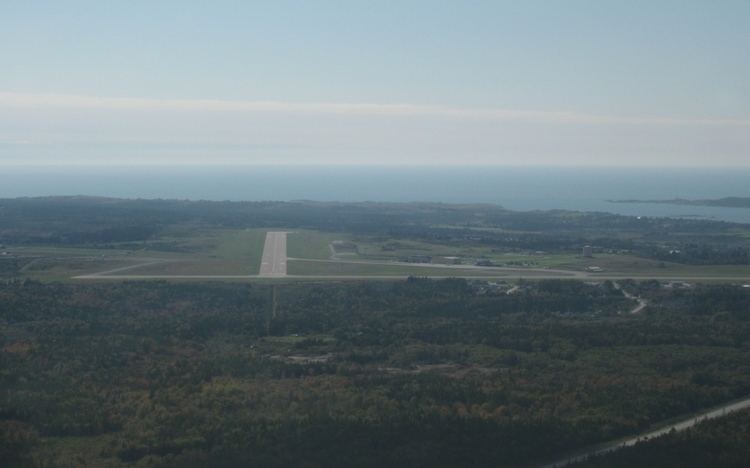Airport type Public Elevation AMSL 140 ft / 43 m Code YQI | Website yarmouthairport.ca Elevation 43 m Phone +1 902-742-6484 | |
 | ||
Location Yarmouth County, Nova Scotia Address 310 Forest St, Yarmouth, NS B5A 4A8, Canada Similar Bay Ferries - Yarmouth, Yarmouth Ferry Terminal, Cloud Nine Shuttle Service, Port of Yarmouth ‑ Operations, Yarmouth Area Industrial | ||
Midland transport terminal yarmouth airport aug 3 16
Yarmouth Airport (IATA: YQI, ICAO: CYQI) is located in Yarmouth County, Nova Scotia, Canada. It began as a World War II Royal Air Force training base.
Contents
- Midland transport terminal yarmouth airport aug 3 16
- Second World War
- Postwar
- Facilities
- Notable events
- References
The airport is classified as an airport of entry by Nav Canada and is staffed by the Canada Border Services Agency (CBSA). CBSA officers at this airport can handle aircraft with no more than 110 passengers or 225 if offloaded in stages.
Second World War
In 1936, the Department of National Defence selected the site as a base for Maritime patrol aircraft. The airbase had two parts, East Camp and West Camp. The West Camp was home to the Royal Canadian Air Force while the East Camp was part of the British Commonwealth Air Training Plan. At East camp, the Royal Air Force's No. 34 Operational Training Unit (OTU) was located at Yarmouth from April 1942 to June 1942, but was then relocated to RCAF Station Pennfield Ridge, New Brunswick in June 1942. In November 1942 the Royal Navy established the No. 1 Naval Air Gunnery School (NAGS), flying the Fairey Swordfish. No. 1 NAGS ceased operations in March 1945.
In addition to the Naval Air Gunnery School, several individual squadrons and units called RCAF Yarmouth home at various times during the war, including:
In addition, No. 419 Squadron RCAF and No. 428 Squadron RCAF were disbanded in Yarmouth in September 1945 after the Surrender of Japan. Both squadrons, flying the Avro Lancaster, were to be trained and re-equipped for the Commonwealth Tiger Force in the Pacific Theatre.
Postwar
After the war, the airfield switched to public/commercial use when it was transferred to Transport Canada. Regular scheduled flights were started by Trans-Canada Airlines (TCA), which became Air Canada in 1965. Ownership of Yarmouth Airport was transferred from Transport Canada to the Yarmouth Airport Commission Association on October 1, 1997. Air Canada flights into Yarmouth ceased in January 2003. Since then, several small operators have provided air service between Halifax and Yarmouth at various times. These include Sou'West Air, who covered the route in 2003, and Starlink Airlines, which flew between Halifax, Yarmouth and Portland, Maine in 2009. The latter lasted less than one year, despite a $2 million provincial government subsidy meant to carry the airline through the first few years of startup. From March 15, 2010 to December 31, 2012, an American company, Twin Cities Air Service, provided service between Yarmouth and Portland with scheduled flights several times a week.
Facilities
Yarmouth Airport facilities include a modern airport terminal building and combined services building which houses a maintenance garage. The airport has two runways, two taxiways and separate parking aprons for commercial and general aviation. In the summer of 2013, its Category I instrument landing system (ILS) was decommissioned, however, GPS (RNAV) approaches exist for all runways, and a VHF omnidirectional range/distance measuring equipment (VOR/DME) and non-directional beacon (NDB) remain active. The airport property has 3.16 km2 (1.22 sq mi) of easily accessible, industrial real estate.
The Yarmouth Airport is home to the Tri-County Flying Association (informally known as the Yarmouth Flying Club). This non-profit flying club has a small clubhouse located on the field and operates a Cessna 172 available for rental by its members.
Notable events
On November 11, 1971, an Iberia Airlines 747 jumbo jet en route from Madrid to New York City made an emergency landing at the airport due to a bomb threat. It was the first time a 747 had ever attempted an emergency landing at such a small airport. Even though the jet successfully landed, the runway was too short for the 747 to take off with passengers on board. The passengers were then flown to New York on three Air Canada DC9s, and early the next morning the 747 took off for New York. No bomb was ever found and the 241 passengers and 18 crew were unharmed.
